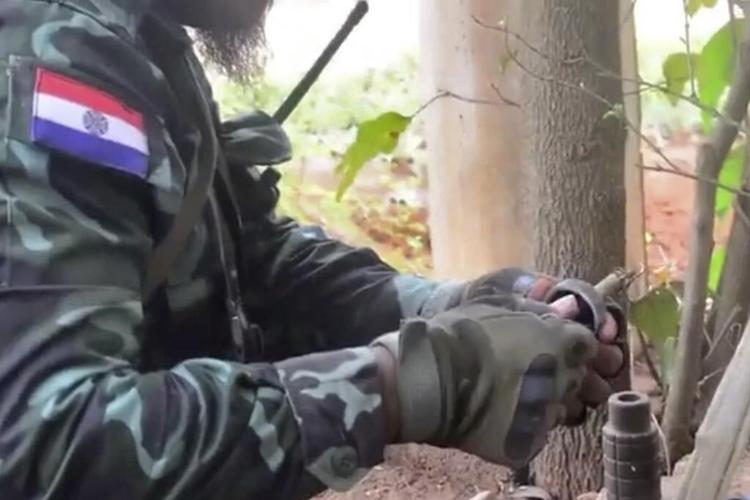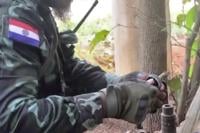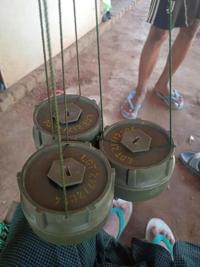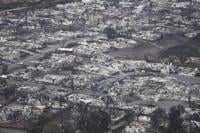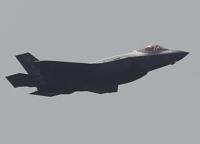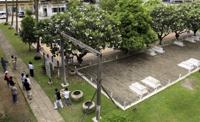BANGKOK (AP) — The 3-year-old boy had taken only two steps from his mother’s lap when a deafening explosion rang out. The blast caught the woman in the face, blurring her vision. She forced her eyes open and searched for her son around the busy jetty where they’d been waiting for a ferry, near their small village in south-central Myanmar.
Through the smoke, she spotted him. His small body lay on the ground, his feet and legs mangled with flesh peeled away, shattered bones exposed.
“He was crying and telling me that it hurt so much,” she said. “He didn’t know what just happened.”
But she did.
___
The woman's son had detonated a landmine, an explosive device designed to mutilate or destroy whatever comes into its path.
have been banned for decades by most countries, since the United Nations Mine Ban Treaty was adopted in 1997. But in Myanmar, which is not party to the treaty, the use of mines has soared since the military seized power from the democratically elected government in February 2021 and armed resistance
Landmines are planted by all sides of the in Myanmar, and they’re responsible for surging civilian casualties, including an alarming number of children as victims, according to an AP analysis based on data and reports from nonprofit and humanitarian organizations, interviews with civilian victims, families, local aid workers, military defectors and monitoring groups.
In 2022, figures from the U.N. show, civilian casualties from landmine and unexploded ordnance spiked by nearly 40%. Experts say this and other official tallies are vastly undercounted, largely due to difficulties monitoring and reporting during the conflict.
Despite incomplete numbers, experts agree that the increase in Myanmar is the largest ever recorded.
Virtually no area is immune to the threat. Over the past two years, mine contamination has spread to every state and region except for the capital city, Naypyitaw, according to , a group that tracks global landmine use.
The military also uses civilians as , a practice widespread in the country for decades but raising alarms with increasing mine incidents. AP's analysis found the military, known as , forced people to walk ahead of troops to detonate potential landmines in their path, protecting their own troops.
According to local and international human rights groups, the Tatmadaw has mined homes, villages, walking paths, church compounds, farms, cellphone towers and a Chinese-backed oil and gas pipeline and copper mine.
The Myanmar military, which has acknowledged mine use in the past, did not respond to a list of questions AP sent to their official spokesperson's email.
Even when the fighting moves on, the landmines don’t. The mines left behind can indiscriminately maim or kill those who happen upon them for years after hostilities have ended.
It raises the specter of casualties for years to come. In countries including Egypt , people continue to die from millions of mines left behind long after conflicts has ended.
___
“Leaving an activated mine like this is the same as releasing a monster,” said a 26-year-old military defector who worked as a combat engineer platoon commander in Myanmar. “Mines don’t have friends or enemies. Even a gun only shoots in the direction it’s pointed.”
Like most who were interviewed by AP, the defector spoke on condition of anonymity to protect himself and his family from military retaliation. Many in Myanmar who speak with reporters .
Landmines and unexploded ordnance have been a persistent issue in Myanmar for more than four decades. The problem has grown exponentially since , with heavier use of landmines in more parts of the country, said Kim Warren, a U.N. landmine specialist who's monitored issues in Myanmar.
In 2022, 390 people were victims of landmines and unexploded ordnance in Myanmar, more than a 37% increase from 2021, compiled by UNICEF. Overall, 102 people were killed and 288 were wounded, with children making up some 34% of the victims, compared with 26% in 2021.
Still, Warren said, incidents are underreported. She cited the lack of a robust information management system, the sensitivities around reporting conflict-related data, and difficulties getting care for victims.
Yeshua Moser-Puangsuwan, Landmine Monitor’s Myanmar expert, said his group counts only casualties it can confirm with confidence.
“We’ve always been undercounting,” he said. “How many more? Double? Almost certainly. Triple? Could be.”
Experts concede the total number of casualties may seem small, with Myanmar’s population of about 56 million, but say the rapid increase is distressing nonetheless, given the underreported cases, the destructive nature of mines and their use amid the decades-long conflict.
Experts are particularly concerned about children victims, like the boy who triggered the mine at the jetty. Many are unaware of how lethal landmines and unexploded munitions are; some pick them up and play with them.
Most children are no longer in school amid the conflict, leading to more unsupervised time. Violence has also forced more than 1.2 million people from their homes, according to the U.N., so children and others frequently move around in unfamiliar areas.
Many civilian victims encounter landmines during daily routines — just going about their days until life changes forever.
___
In March 2021, two teenage cousins were working on a small family-run plot in Shan state. They had just left to dig for sweet potatoes when the father of one of the boys heard a blast from his home. He rushed to help, but he was too late. They'd been killed instantly. They’d triggered a mine.
The father, 47, tears up when he returns to the fields, where he found tattered clothes and mangled bodies.
“But it’s my family’s business, so I have to come to the farm to make a living,” said the man, who spoke on condition of anonymity to protect himself and his relatives.
On the other side of the country, in western Chin state, a 20-year-old farmer was returning home from weeding a rice paddy field on a sunny May day when he triggered a mine buried on a path he’d walked many times before.
“The explosion engulfed me, and my entire surroundings were clouded in smoke. I thought I was dying,” he told AP on condition of anonymity, out of fear for his safety. “I could see bones. The right leg was completely destroyed up to the ankle. My whole body was hot as if it was on fire and my skin was black.”
During his 18-day stay in the hospital, his right leg was amputated about four inches below the knee.
Many victims and families won't know who was responsible for the blasts — the Tatmadaw or anti-military groups — as all sides of the conflict use mines.
A member of a militia that operates in Sagaing said his group has removed nearly 100 mines thought to be planted by the military and plans to reuse them to augment its arsenal of homemade devices.
“A mine is an indispensable weapon to attack the enemy,” said the member, who spoke by phone on condition of anonymity over the sensitive information and fear the military would retaliate against his family.
It’s a common practice: Militias and armed groups announcing they’ve demined areas where they operate, only to reuse the weapons.
“They just move the mines to a new location,” Moser-Puangsuwan said. “And that is not what we call demining.”
The militia member said villagers are warned of mine locations and civilians are rarely harmed. But Moser-Puangsuwan and other experts said it’s just not possible to prevent civilian casualties.
“They’re using an indiscriminate weapon,” Moser-Puangsuwan said. “Once it’s out there, it will kill or injure the next person who comes across it, whether they’re the enemy, whether they’re one of the soldiers on your side, or whether they are civilians.”
One man in Myanmar’s western Chin state described how soldiers took him, his pregnant wife and their 5-year-old daughter captive, making them and 10 other civilians to walk ahead, beating them with rifles if they refused.
The civilians moved slowly ahead through the suspected minefield, expecting with each step to trigger a blast, while a firefight between an anti-government militia and the soldiers broke out, he said.
“I thought: ‘Today is the day I die,’” said the man, who also spoke on condition of anonymity for fear of reprisal. They later escaped, with no mines detonated during their march.
Landmine Monitor documented similar incidents in other states, calling it a “grave violation of international humanitarian and human rights law” in its most recent report.
Myanmar were the only states with documented new use of mines in 2022, according to Landmine Monitor, though Human Rights Watch in January alleged Ukraine also used antipersonnel mines when Russian forces occupied the . Non-state armed groups have also been confirmed to be using them in at least five countries in 2022, including anti-government forces in Myanmar.
Myanmar and Russia are among countries that aren't signatories to the 1997 Mine Ban Treaty, along with China, North and South Korea, and the United States.
Landmine Monitor also confirmed the military has been increasingly mining infrastructure such as mobile phone towers and power lines to deter attacks. Military-planted mines also are protecting at least two major Chinese-backed projects — a copper mine in Sagaing and a pipeline pumping station in northeastern Shan state that is part of China’s Belt and Road initiative, Moser-Puangsuwan said.
“We are not aware of the situation you mentioned," a spokesperson for China’s Ministry of Foreign Affairs wrote in a fax to AP. "The cooperation project between China and Myanmar is in line with the common interests of both sides and has brought tangible benefits to the people of Myanmar.”
It made no reference to any of those who had been maimed.
___
For those who survive a blast, health care is difficult to access. Many areas are remote, with limited road infrastructure or access to medical facilities. Staffing is low; health workers are often forced to go into hiding or leave Myanmar over . Few victims can afford prosthetics and rehabilitation.
At the jetty, the explosion that maimed the 3-year-old boy set off a frantic search for help, with his mother traveling dozens of kilometers across rural countryside by motorbike and boat.
A small clinic on the other side of the river gave basic first aid and morphine for pain. A larger rural clinic bandaged wounds and provided a blood transfusion. It wasn't until the pair got to the main hospital in the regional capital that doctors were able to amputate both of the boy's legs — the right below the knee and the left just below his hip.
The hospital bill was more than six times the family's monthly income of 400,000 Myanmar Kyat ($190).
For months, the boy used a wheelchair. He would stare out the window of their small wooden home, watching friends play. “I just want my legs back,” he'd say.
In November, he was admitted to an orthopedic rehabilitation center. The Red Cross paid for quality prosthetic limbs and taught him to use them.
Now 4, the boy is back home and can move around on his own, allowing his mother to go back to work in the bean fields.
He speaks frequently about the blast, but his mother isn't sure he'll ever process what happened. And the family will never be the same.
“Maybe he still doesn’t understand,” she said. “He is still young.”
___
Find more of AP’s Asia-Pacific coverage at

